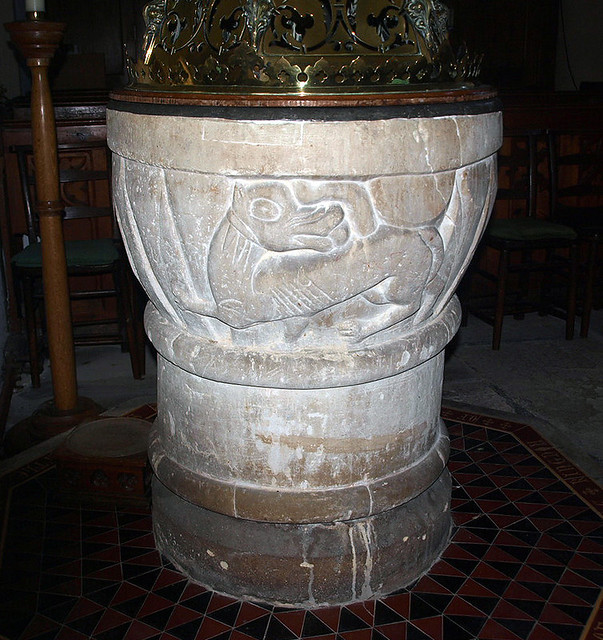ST MARGARET. 1869-78, but old unbuttressed red sandstone W tower with stair-turret. - FONT. Norman, circular bowl with a large fluted zigzag motif and in one place an animal, its head looking backwards, its mouth holding an apple (?). - MONUMENTS. Two by Chantrey, one for Admiral Sir John Duckworth, d. 1817, with a relief of a naval battle, the other (d. 1811) of less interest.
TOPSHAM. It has had an eventful past since that day in 1282 when a petulant countess dammed the river Exe to divert sea trade from Exeter to this small port, because Exeter had offended her.
When Exeter’s ship canal was cut opposite Topsham in 1563 this port saw most of its old trade go sailing by, but still considered itself big enough to man a ship to fight the Armada. Then, after the Civil War, came a company of Dutch merchants to settle on this high promontory between two rivers, the Exe and the Clyst. We may see their gabled houses in the Strand, the old fashioned street which twists and turns beside the curving river. They are much as the merchants knew them 250 years ago, still with the little cottages for their clerks.
One bow windowed house on the Strand has a tablet telling us that Sir William Webb Follett was born here in 1798. Son of a timber merchant, his rise in the legal profession was without a hitch till disaster came in the form of paralysis. He had to address Parliament sitting in a high chair, and within a year his brilliant career was over. He was only 47 when he was laid in a vault under Temple Church, and there were few who did not echo Lord Hatherley’s description of this great advocate, that "in every qualification of intellect and grace of manner he was as nearly perfect as man can be."
We come up 50 steps to the church and find here two other Topsham men made famous by Chantrey, though indeed they are famed for their own good deeds. They are Admiral Sir John Duckworth and Colonel Duckworth his son. The son is a marble figure between trumpeting angels, the trumpets sounding for his heroism in leading a charge at Albuera, one of the bitterest battles ever fought by British troops. The father has a marble bust and a sculptured relief of the battle scene when he forced the Dardanelles; we noticed in it a sailor clinging to a piece of wreckage in the water.
The church shares with the Strand its view over the water to where Great Haldon rises among the hills, and though it has been made new its red tower has for centuries been a landmark for shipping. Besides its Chantreys it has a great treasures of sculpture 800 years old, a font made by a Norman mason, who chiselled on the bowl a queer animal (with its tail between its legs) which a modern child might recognise as the big bad wolf. The font has a pointed brass cover.
By the old home of the Duckworths is the long red span of the Countess Weir bridge over the Exe. Named after the petulant lady who would have cut off Exeter’s trade, it is ironical to find it now where five ways to Exeter run side by side, railway, river, and canal between two roads.
Near the railway station is a brick church with a small tower, a Roman Catholic church which moved us as a striking example of an old man’s devotion to his faith. We found him digging the garden to make the waste land blossom as the rose round the simple church he had built after more than forty years of missionary work on another continent. Proud of the little red tower with its wide view over land and sea, he was prouder still of a piece of good fortune which had brought to his church a fine statue by Harry Hems, the Devon sculptor. It shows Our Lord with a child in his arms and is full of tender feeling. God had sent it to him, the old priest told us; a lady had bought it at an auction for a few pounds, although it had won a gold medal for the artist when exhibited in Philadelphia; and the lady had given it to the new church. In the small chapel the altarpiece is a lovely old triptych with paintings of the Crucifixion in the centre and the Visitation and the Presentation on the wings. We found this devoted priest, young at 80, about to build a house for himself so that he could live by the neat little church which he had built mainly out of his savings.



No comments:
Post a Comment